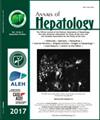Soft drink consumption and increased risk of nonalcoholic fatty liver disease: Results from the health workers cohort study
IF 3.7
3区 医学
Q2 GASTROENTEROLOGY & HEPATOLOGY
引用次数: 0
Abstract
Introduction and Objectives
Nonalcoholic fatty liver disease (NAFLD) is a common clinical condition and an important public health problem. Some epidemiological studies have suggested that soft drinks (SD) intake is associated with NAFLD. However, the evidence is inconsistent. Our objective was to assess the association between SD consumption and the risk of NAFLD in a Mexican adult population.
Materials and Methods
A total of 1,759 participants from the Health Workers Cohort Study (HWCS) were included in the analyses. SD intake was measured using a validated food frequency questionnaire. We classified SD consumption as follows: a) less than 1 serving per week, b) 1 to less than 3.5 servings per week, and c) 3.5 or more servings per week. Hepatic steatosis index (HSI) was calculated based on sex, BMI, and blood transaminase levels, and was categorized as NAFLD ≥ 36. To assess the relation between SD and NAFLD, we followed two approaches: fixed effects logistic regression and generalized estimating equations.
Results
After adjusting for demographic characteristics, lifestyle factors, and dietary intake, the odds ratio (OR) and 95 % confidence interval (95 % CI) for NAFLD were 1.26 (95 % CI: 1.08, 1.48) for 1 to less than 3.5 servings per week and 1.42 (95 % CI: 1.19, 1.69) for ≥3.5 servings/week category in both sexes. When stratifying the analysis by sex, we observed that the association tended to be greater in men than in women.
Conclusions
The results from our prospective study indicate that SD consumption is associated with an increased risk of NAFLD.
饮用软饮料与非酒精性脂肪肝风险的增加:卫生工作者队列研究的结果。
导言和目标:非酒精性脂肪肝(NAFLD)是一种常见的临床疾病,也是一个重要的公共卫生问题。一些流行病学研究表明,软饮料(SD)摄入量与非酒精性脂肪肝有关。然而,相关证据并不一致。我们的目的是评估墨西哥成人非酒精性脂肪肝与软饮料摄入量之间的关系:共有 1,759 名来自卫生工作者队列研究(HWCS)的参与者参与了分析。SD摄入量通过有效的食物频率问卷进行测量。我们将 SD 摄入量分为以下几类:a) 每周少于 1 份;b) 每周 1 至少于 3.5 份;c) 每周 3.5 份或更多。根据性别、体重指数和血液转氨酶水平计算肝脏脂肪变性指数(HSI),并将其归类为非酒精性脂肪肝≥36。为了评估SD与非酒精性脂肪肝之间的关系,我们采用了两种方法:固定效应逻辑回归和广义估计方程:在对人口统计学特征、生活方式因素和饮食摄入量进行调整后,非酒精性脂肪肝的几率比(OR)和 95 % 置信区间(95 % CI)分别为:每周 1 至少于 3.5 份的男女为 1.26(95 % CI:1.03,1.55),每周≥3.5 份的男女为 1.42(95 % CI:1.15,1.74)。在按性别进行分层分析时,我们发现男性的相关性大于女性:我们的前瞻性研究结果表明,食用 SD 与非脂性脂肪肝风险的增加有关。
本文章由计算机程序翻译,如有差异,请以英文原文为准。
求助全文
约1分钟内获得全文
求助全文
来源期刊

Annals of hepatology
医学-胃肠肝病学
CiteScore
7.90
自引率
2.60%
发文量
183
审稿时长
4-8 weeks
期刊介绍:
Annals of Hepatology publishes original research on the biology and diseases of the liver in both humans and experimental models. Contributions may be submitted as regular articles. The journal also publishes concise reviews of both basic and clinical topics.
 求助内容:
求助内容: 应助结果提醒方式:
应助结果提醒方式:


